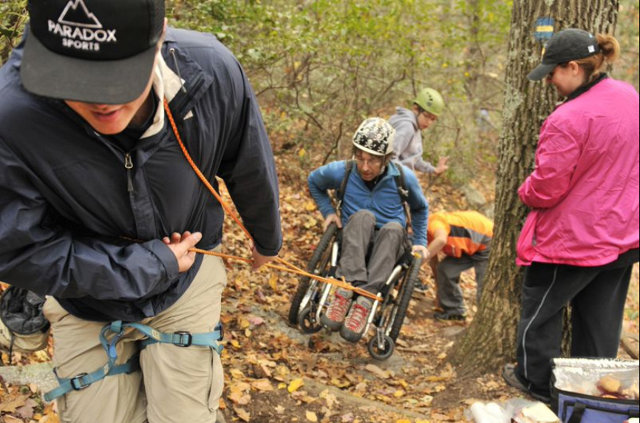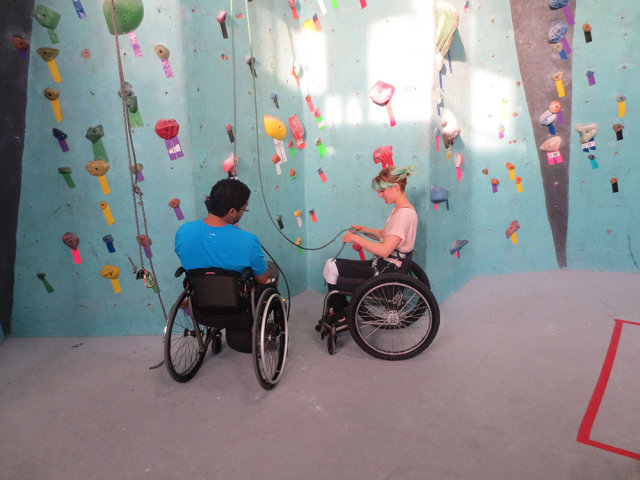On a muggy Sunday night in South Brooklyn, a petite redhead with pale green highlights in her hair works her way up a 35-foot wall at the cathedral-like indoor climbing mecca known as Brooklyn Boulders. At first glance, Chloe Crawford looks like just another hipster. But then you notice the wheelchair on the ground beneath her and how she's pulling herself up using nothing but her arms, as her legs dangle beneath her.
"This is a lot harder than a pull-up," Crawford says, once she's finished the climb and is back in her chair. "When you do a pull-up, you have both your hands around a whole bar. With this, you may have room for just a few good finger holds." What's more, "at some point you have to take your hand off the wall and reach up, so it's like doing a one-arm pull-up."

Later that week, the 30-year-old artist from Mount Kisco, NY would go on to earn a gold medal at the USA Paraclimbing Nationals in Atlanta. She beat the other "sit climbers" in her class by climbing the furthest up a 20-foot wall without stopping to rest. Next she heads to Spain this September for the paraclimbing world championships.
"I always wanted to do climbing, but I never imagined being able to because these opportunities didn't exist three years ago. I feel like I caught it just at the right time," says Crawford.
Pioneered in the late 1980s by extreme athlete Mark Wellman, adaptive climbing has only recently become accessible to novices, thanks to growing awareness of the sport and better equipment to help make it possible. When Wellman became the first paraplegic to summit the 3000-ft. granite face of El Capitan in Yosemite National Park in 1989, he made the historic ascent one painstaking pull-up at a time using a compact pullup bar attached to a motion-capture system he invented to keep from sliding back down the rope between pull-ups. It took 7,000 pull-ups to make it to the top.
For anyone who struggles to do even a single pull-up, Wellman's feat is nothing short of miraculous. Rock climbing is difficult and dangerous even when you can use all your limbs. But for those faced with a physical disability, overcoming those limitations is half the draw. "You are basically in a wheelchair all day long and to be able to get out of a wheelchair and be able to do things that other people are doing is a definite boost to your self-esteem," says Enock Glidden, 36, of Bethel, Maine, who was born with spina bifida and uses the pull-up system invented by Wellman to aid his ascents.
Now there's a whole range of adaptive devices aimed at lowering the barriers to entry. Special harnesses and pulley systems let beginners use their own strength to ascend even if they can't do a full pull-up. Padded chaps protect paraplegics' legs from sharp rock. Prosthetic climbing feet give lower-leg amputees better balance and control. There's even a prosthetic knee that improves the range of motion for above-knee amputees. Jarem Frye, who lost a leg to cancer at age 14, invented the knee and wore it during the first all-amputee ascent of El Capitan in 2012. The group--which included Craig DeMartino, who is missing a leg, and Pete Davis, who's without an arm--made it to the top in five days, which is faster than many able-bodied climbers accomplish the feat.Their achievement proved a point: "We had all been hanging out with these able-bodied guys who got the credit for dragging these gimps around, when in reality it was the other way around," says Frye.

While almost any sport can be modified for those with handicaps, rock climbing is especially versatile. Neil Taylor, 35, of Brattleboro, VT got hooked after he lost his sight six years ago due to a malignant brain tumor. A former downhill skier and lacrosse player who now works as a massage therapist, Taylor doesn't need any special equipment. Instead, he relies on his sense of touch to locate his next handhold. "Climbing is tactile, it's feeling for holds that can support your weight," he says. "I can't do half the things I used to, but being totally sightless I can feel the rock better than someone who has sight. I have always been an adrenaline junkie, and I can get that thrill from rock climbing," he says.
The biggest hurdle for newly-disabled climbers is often psychological. Quemuel Arroyo is a 25-year-old policy analyst for the Department of Transportation whose his legs were paralyzed in a mountain biking accident six years ago. Although he had climbed before his accident, he initially resisted the idea of getting back into the sport because, "I didn't want to be labeled as a disabled person."

Now Arroyo climbs twice a week with the Adaptive Climbing Group in Brooklyn, which has been holding regular climbing sessions both at indoor gyms and outside on real rock since 2012. "We climb the exact same routes as everybody else," says founder Kareemah Batts.
Adaptive climbing has even been used to help veterans recover from PTSD, traumatic brain injury and other ailments. Tim O'Neill of Paradox Sports, who recently led a group of nine veterans through Grand Teton National Park in Wyoming, says the trip helped to remind them that "your life isn't over. It's just begun again in a new way."






![Robert Priest - People Like You and Me (2024) [Hi-Res]](http://www.dibpic.com/uploads/posts/2025-07/1751805912_lhttl01vuwv8a_600.jpg)








